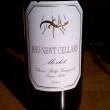Admitting What We Don’t Know: Aging Potential for New York Wines
By Evan Dawson, Managing Editor
 The other day I read a truly outstanding piece of wine writing by one of the most underrated writers in the field today. He's underrated probably because he's not actually in the wine writing field; Keith Levenberg is an enthusiast who makes his living elsewhere, but every six weeks or so, he rewards readers with his insights. His blog is not unlike your favorite greasy spoon tucked into high-end restaurant row: You always see the same dozen people there, and they realize that the place is going to be packed if anyone ever finds out how good the fare is.
The other day I read a truly outstanding piece of wine writing by one of the most underrated writers in the field today. He's underrated probably because he's not actually in the wine writing field; Keith Levenberg is an enthusiast who makes his living elsewhere, but every six weeks or so, he rewards readers with his insights. His blog is not unlike your favorite greasy spoon tucked into high-end restaurant row: You always see the same dozen people there, and they realize that the place is going to be packed if anyone ever finds out how good the fare is.
It was Keith's piece on how wines mature that had me thinking of New York wines. Specifically, I'm thinking about Finger Lakes rieslings and Long Island reds, which, categorically speaking, are the state's wines that have the best potential for long-term improvement in the bottle.
It's time that we admit what we don't know. And it's time we recognize how thrilling that is.
In older wine regions, we get a good look at what might happen a decade or three down the line. Sure, vinification techniques change. But there is a reason to believe that we know what the special bottlings of, say, Cote-Rotie might do with time.
But as Keith makes clear, there's way too much posturing and affectation when critics try to slap a "drink window" on structured wines:
In its simplest form, the thought process goes something like this: Tannins help a wine age, and this wine is tannic; therefore it needs time. There are endless variations on the theme: As wines age they lose their baby fat, and this wine has a lot of baby fat; therefore it will be a long time before it fades. Or: Wines integrate with age, and this wine seems very disjointed; therefore it just needs some time to come together. Or: Wine ages on its balance, and this wine is perfectly balanced; therefore it will age effortlessly. You can pluck any one you want to justify any arbitrary prognostication. For example, one person tastes a heavily tannic, backwards wine and concludes it’s structured for long aging. Another person tastes the same wine, decries its lack of balance, and quotes the late Henri Jayer: “If it tastes too tannic, then it is too tannic.” Which one is right? Answer: It depends. Some wines have a track record for starting out punishingly tannic and eventually becoming exquisitely finessed, while other wines that might seem structurally indistinguishable from the starting gate never manage to shed the harshness–or, just as disappointingly, they do shed the tannin but don’t reveal anything interesting in the material that remains.
He's right, of course, and if I spent five minutes I could probably find an instance or two in which I over-pronounce or, perhaps, speculate carelessly. It's tempting to do, but most of the time we're really just bullshitting. And it's a great way to get into trouble; few things provoke the kind of public opprobrium that comes when a critic urges his readers to lay down an expensive bottle that quickly goes downhill.
But we should feel no frustration with the lack of precision with which we can anticipate New York wines' aging curves. Instead, we should enjoy this opportunity to witness an evolution, of wine regions from nascency to actualization. How good will the best Long Island merlot be in twenty-five years? I can guess, and Lenn can guess with better authority than most. But the ledger is so thin that we're still simply guessing, and to Keith's point, we'll always be simply guessing.
Do not take this to say that we don't have any clue at all what New York wines will do with some amount of bottle age. We've seen enough example of, for example, Bedell's or Paumanok's merlots to understand their potential over a decade or so. Same with the rieslings — and particularly the late harvest rieslings — of Hermann J. Wiemer. There are other examples. But we need not obsess over nailing down the projected pinnacle of each of New York's finest wines. We can track the progress as it happens, sometimes rewarded, sometimes disappointed. Just remind yourself that a wine that is, to use a common phrase, "past peak" is simply communicating different things. It is very often a highly enjoyable story if you're willing to listen to it.
There will be some changes coming to NYCR in 2012. Among other projects, Lenn and I are planning to create a rough vintage guide. Not a typical vintage chart, but a helpful report on recent vintages. But no matter what the vintage evaluation, there will be surprises, and if we ever tell you we know exactly when a wine will peak, well…















Thanks, Evan! This is exactly the kind of thinking I was hoping to provoke-what to make of those wines that seem to have the customary “ingredients” for aging but no actual examples we can point to of their evolving the way the soothsayers predict. It’s a particularly interesting question in the case of emerging regions where the wines might remind us of more established regions in certain respects, but which will age based on what their own terroirs dictate regardless of what they can be compared to when they’re two years old. I’m always humbled by your positive outlook on things and you’re absolutely right to point out that the excitement of getting to watch the future unfold far outweighs the disappointment of realizing that all those predictions we tried to make were bullshit.
Keith - I continue to laud your work because it’s so good, and selfishly I’d like more of it, but of course I recognize that it’s not so simple. Maybe you don’t have the time, or maybe you feel that the law of diminishing returns comes into play.
There is a certain parlor-game feeling to the attempt at guessing a wine’s window, not all that different than blind tasting but with much delayed gratification. I enjoy the conversation, but I probably become unjustifiably authoritative at times if the subject is Finger Lakes wines. The bottom line is sample size, and we just don’t have a very big one.
And yeah, terroirs can fool us into finding commonalities, only to see the subtle differences change the game over time. We can be easily misled.
Big thumbs up on the vintage guide concept.
The wines have to be made with the thought of aging potential. Sadly, most techniques these days are developed and used to get the wine on the market as easy to drink as possible. Both red and whites. So structure is sorely lacking in most wines that are manipulated to be ready to drink in months (or weeks) not years.
Overall wine ageing is overrated. Too many wines do not live up to expectations. It may be that the expectations were misplaced.
Yet the question of how well or do NY wines age is a good one. We did take a good look at it back on March 19, 2011 in a tasting that Lenn published here on April 6, 2011, I believe. In the article Lenn describes enthusiastically how well 26 Long Island wines showed. They were from 1990 to 2000.( so up to 21 years of age). 10 wineries were included. Of 26 bottles a couple were corked but the rest were surprisingly alive. If possible can some one at the NYCR include a link in Evan’s piece to Lenn’s article as they complement each other.
My favorite line, and strong belief: “aging is overrated!”
Charles, Todd - overrated?
Depending on what you expect from drinking wine aging may be overrated. One of the reasons why I have become passionate about wine is its capability of transformation over time. Obviously, not all wines are meant to be put away for a decade and if you decide to store such a wine it will certainly not live up to your expectation.
If, however, a wine with sufficient structure to mature ages well over time then the reward can be marvelous. As both Keith in his original article and Evan in his response point out, there is no formula (thank goodness) for the potential of aging- it will always be a gamble whether or not we will be able touch the sublime spot in a wine. But if we do then the very experience of it can’t be rated high enough in my opinion.
Uwe,
Fair enough and I do enjoy a wine that has aged well.
What I am alluding to is that there is a lot of misconception about wine and its aging potential, ever since Paul Masson’s infamous “We will sell no wine before its time”. So many people automatically assume that because a wine is older it is therefore better or that a simple wine will somehow evolve into a great wine if it is older.
As you state there are wines, and these are few, that have the structure to allow them to improve if aged in a proper environment. My observation is that it is common for many people to stretch that to include most wines. You could say that perhaps they need education. If so it is relevant to point out this pitfall and in that sense the idea of aging is overrated.
With this caveat, and going back to the original thread, you may want to browse through the NYCR back to April 6 and read Lenn’s review of the tasting of 26 Long Island wines from 1990 through 2000. The overall perception was that they aged very well.
Cheers,
Aging and improving are two different things. Some wines get old without improving necessarily. I feel like Zinfandel can be guilty of that over the long term.
I believe ALL WINES improve a bit with age - whether that is the first three months after bottling to shake off the “bottle shock”, or a year to smooth out the edges and better “integrate.” The question isn’t about aging wines being a good idea or a bad one, rather HOW LONG should a wine be kept to be at its best? Sometimes the answer is a year or two - that would be true of nearly any wine made. The follow up question becomes “did the wine improve and in what way?”
If a wine will not improve in any way after being bottled, it can only be said to be “in decline.”
I’ve had delightful experiences with older Finger Lakes reislings — older as in 10-12 years — but I wonder about how and whether the evolving FL style will change how they age. I enjoy my reislings with a few years on them, and circa 2000 Finger Lakes reislings (my favorites, at least) had a strong mineral pinning and a lot of acidity, the first giving a backbone to petrol-type flavor development and the latter keeping the texture from feeling too flabby. Certainly winemakers are still making these “steely” reislings, but I see the region gradually gravitating towards a riper style that, honestly, I feel may not age as prettily. I do look forward to finding out, all the same!